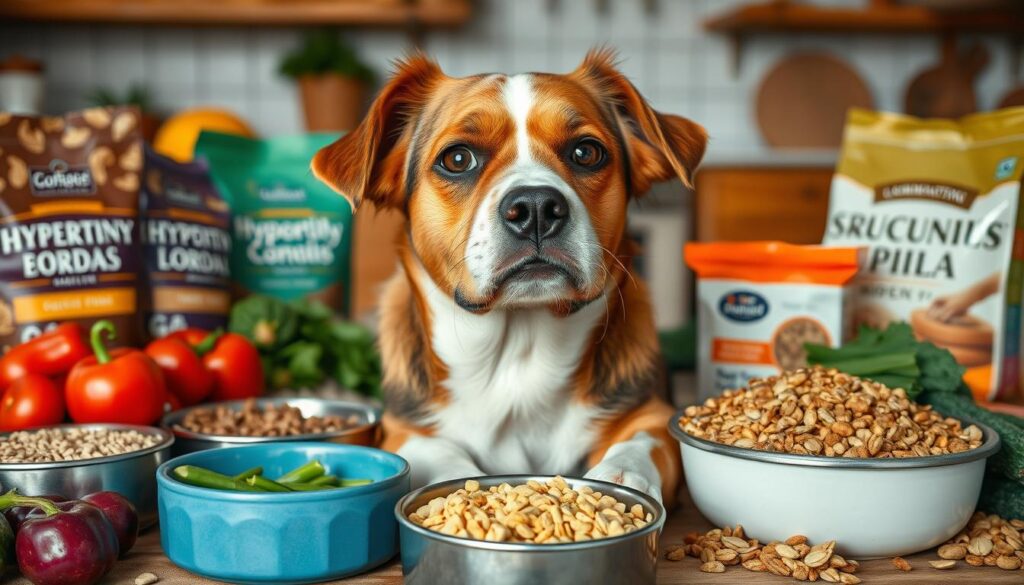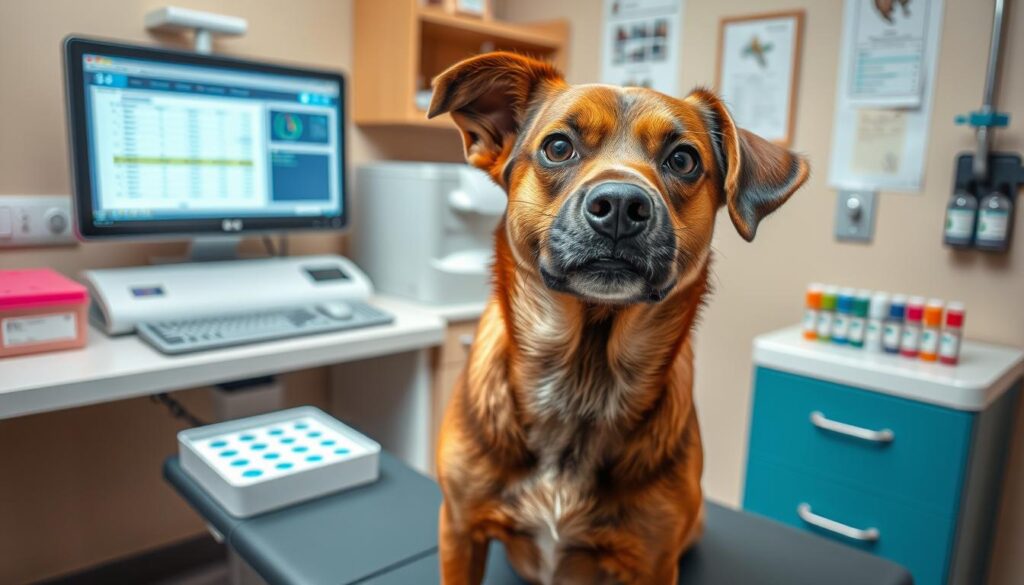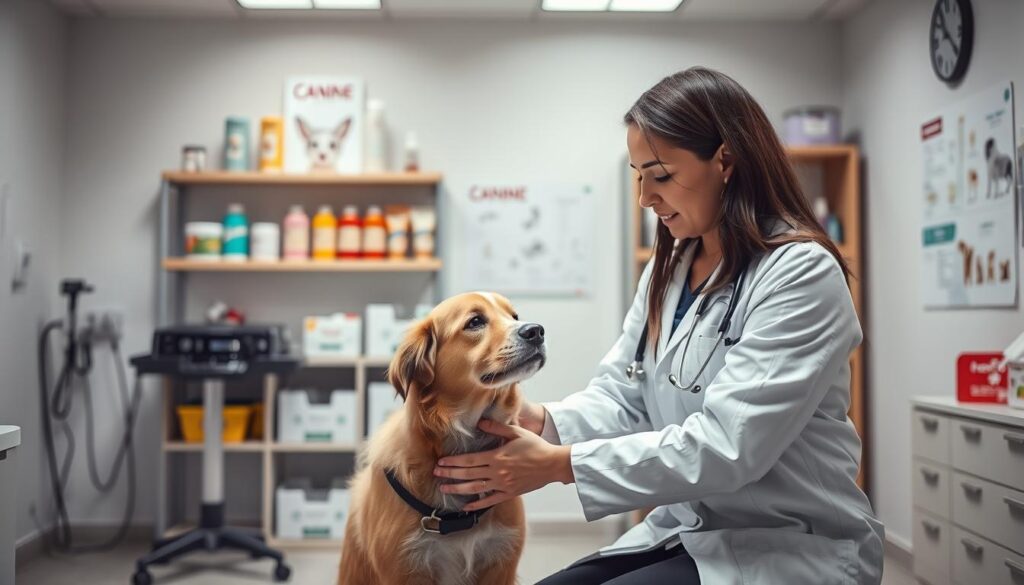Dealing with dog food allergies can be tough for pet owners. Canidae is known for its quality ingredients and care for pets. But, even top dog foods can cause allergic reactions in dogs. This guide will help you manage Canidae dog food allergies, keeping your pet happy and healthy.

Key Takeaways
- Understand the common symptoms and signs of dog food allergies
- Explore the unique features of Canidae dog food that may contribute to allergic reactions
- Discover the alternative Canidae product lines designed for dogs with sensitive stomachs
- Learn about natural remedies and supplements that can help manage food allergies
- Collaborate with your veterinarian to identify and address Canidae dog food allergies
- Implement prevention strategies to avoid future allergic episodes
- Ensure a smooth and safe transition to a new dog food for your pet
Understanding Food Allergies in Dogs: Symptoms and Signs
It’s important to know the signs of food allergies in dogs to help them quickly. These allergies can cause physical issues or changes in behavior. Keeping an eye on your dog’s health is key.
Common Physical Symptoms
Skin irritation is a common sign of dog food allergy. This can lead to excessive scratching, licking, or chewing of their paws, ears, or other parts. Dogs may also have gastrointestinal issues like vomiting, diarrhea, or loss of appetite.
Behavioral Changes to Watch For
- Increased restlessness or anxiety
- Sudden changes in energy levels
- Excessive yawning or lip-licking
Emergency Warning Signs
A dog’s food allergy can sometimes cause a severe reaction called anaphylaxis. This is a life-threatening condition that needs quick vet care. Look out for difficulty breathing, facial swelling, or even collapse. If you see these signs, get emergency help for your pet right away.
Knowing the symptoms of food allergies in dogs helps you act fast. This ensures your dog stays healthy and happy.
What Makes Canidae Different from Other Dog Foods
Canidae is a brand that stands out in the pet food world. It doesn’t follow the usual path like many other dog food brands. Instead, Canidae focuses on quality and health, making sure pets get the best nutrition.
Canidae uses wholesome, natural ingredients without artificial additives or fillers. They choose premium protein sources like chicken, lamb, and fish. This ensures dogs get the amino acids they need. They also pick carbohydrate sources like whole grains and fresh produce for better health.
| Ingredient Comparison | Canidae | Other Leading Brands |
|---|---|---|
| Protein Sources | Chicken, lamb, fish | Meat by-products, unnamed protein sources |
| Carbohydrates | Whole grains, fruits, vegetables | Corn, wheat, soy |
| Preservatives | Natural, such as vitamin E and rosemary extract | Synthetic, such as BHA and BHT |
Canidae also shines with its quality control and transparency. Their manufacturing meets top standards. They show the quality and source of their ingredients on the packaging. This helps pet owners make better choices for their pets.
Canidae aims for nutritional excellence in their dog food. They want to nourish and support pets’ health. With their focus on natural ingredients and strict manufacturing, Canidae leads the pet food industry. They offer a great choice for pet owners looking for something different.
Common Ingredients in Canidae That May Trigger Allergies
Looking into dog food allergies, we need to examine Canidae’s ingredients closely. This top pet food brand offers quality formulas but may still cause allergic reactions in some dogs. Let’s dive into the possible allergens in Canidae’s products.
Protein Sources
Protein is vital for dogs, but some sources can be allergens. Canidae provides proteins like chicken, lamb, bison, and fish. While these are usually safe, dogs with dog food allergens might react to them.
Grains and Fillers
Grains and fillers add carbs and fiber to pet food. Yet, canine dietary sensitivities to corn, wheat, and soy are common. Canidae offers both grain-based and grain-free options for dogs with pet food ingredients sensitivities.
Preservatives and Additives
Canidae uses preservatives and additives to keep food fresh and tasty. While most are safe, some can cause allergic reactions in dogs. It’s important for pet owners to check the ingredient list for allergy-prone dogs.
| Ingredient Type | Potential Allergens in Canidae | Hypoallergenic Alternatives |
|---|---|---|
| Protein | Chicken, lamb, bison, fish | Limited-ingredient formulas with novel proteins |
| Grains and Fillers | Corn, wheat, soy | Grain-free options, limited-ingredient recipes |
| Preservatives and Additives | Artificial colors, flavors, and preservatives | Formulas with natural preservatives and minimal additives |
Knowing the allergens in Canidae’s dog food helps pet owners make better choices. They can choose alternative Canidae products for sensitive dogs. This way, they can manage dog food allergens and ensure their pets’ health.
Identifying Canidae Dog Food Allergies: A Step-by-Step Guide
Finding out if your dog has a food allergy can be tough. But, with the right steps, you can figure it out. If you think your dog might be allergic to Canidae dog food, here’s how to find out and fix it.
Elimination Diet: The First Step
The elimination diet is a good way to see if your dog has a Canidae food allergy. You’ll need to switch your dog to a special diet. This diet should have a new protein and carb that your dog hasn’t tried before. This helps find out what’s causing the allergy.
- Slowly change your dog’s diet over 7-10 days.
- Keep your dog on this diet for 8-12 weeks, without any other foods or treats.
- Watch your dog’s symptoms closely during this time.
Allergy Testing: Confirming the Diagnosis
If the elimination diet doesn’t work, your vet might suggest allergy testing. This can include skin or blood tests to find out what’s causing the allergy.
| Dog Allergy Testing Method | Advantages | Disadvantages |
|---|---|---|
| Skin Prick Test | Provides immediate results | Can be uncomfortable for the dog |
| Blood Test | Measures antibody levels | Results take longer to process |
It’s important to work with your vet to find out if your dog has Canidae food allergies. They can help you through the process and make sure your dog stays healthy.

Alternative Canidae Product Lines for Sensitive Dogs
Canidae has special lines for dogs with food sensitivities. These options are tailored to meet their dietary needs. They help ease allergy symptoms and discomfort.
Grain-Free Options
Canidae’s grain-free pet food is for dogs sensitive to grains. It uses high-quality protein sources and avoids common allergens like wheat, corn, and soy. This line is nutritious and tasty for dogs with food intolerances.
Limited Ingredient Formulas
Canidae’s limited ingredient diets are perfect for dogs with food sensitivities. They have fewer main ingredients, making it easier to spot and avoid allergens. These grain-free pet food options help with digestive and skin issues in sensitive dogs.
Hypoallergenic Choices
Canidae has hypoallergenic dog food for dogs with severe allergies. These recipes use new protein sources and select ingredients to avoid allergic reactions. They offer a safe and nutritious option for dogs with complex sensitivities.
Canidae helps pet owners find the right food for their dogs’ needs. Whether it’s hypoallergenic dog food, limited ingredient diets, or grain-free pet food, they have solutions for dogs with food allergies.
Transitioning Your Dog to a New Food Safety
Changing your dog’s food can be tricky, but it can be done smoothly. Whether it’s a dog food transition, a pet diet change, or just a canine nutrition adjustment, here are some tips. They’ll help your dog adjust easily.
- Go Slow: Changing food too fast can upset your dog’s stomach. Start by mixing a little new food with the old. Gradually increase the new food over 7-10 days.
- Monitor for Reactions: Watch your dog closely during the change. Look for signs like vomiting, diarrhea, or skin issues. If you see anything bad, call your vet right away.
- Ensure Proper Nutrition: Make sure your dog gets all the nutrients they need during the change. Talk to your vet or a pet nutritionist. They can help make sure the new food is good for your dog.
| Transition Timeline | Old Food | New Food |
|---|---|---|
| Days 1-3 | 75% | 25% |
| Days 4-6 | 50% | 50% |
| Days 7-10 | 25% | 75% |
| Day 11 and beyond | 0% | 100% |
By following these steps, you can make a safe and successful dog food transition, pet diet change, or canine nutrition adjustment for your dog. Remember, being patient and careful is important. It makes the change better for both you and your dog.
Natural Remedies and Supplements for Food Allergies
Dogs with food allergies can find relief with natural remedies and supplements. These options target the root causes of allergies. They help improve digestion and boost the immune system, easing allergy symptoms.
Digestive Aids
Probiotics and digestive enzymes are great for a dog’s stomach. They break down tough ingredients, reduce inflammation, and keep the gut healthy. Canidae Probiotic Supplements and Digestive Enzymes for Dogs are excellent choices for dogs with food sensitivities.
Immune System Boosters
Boosting a dog’s immune system is key to managing food allergies. Supplements with omega-3 fatty acids, antioxidants, and herbs can help. Canidae Immune System Support and Allergy Support for Canine Allergies are highly recommended.
Adding these natural remedies and supplements to your dog’s care can offer much-needed relief. Always talk to your vet before starting any new treatment. This ensures the safety and effectiveness of these allergy support options.
Working with Your Veterinarian on Food Allergies
Dealing with pet allergy management can be tough. But, with a trusted veterinary care pro, you can find good solutions. It’s key to work with your dog’s vet to tackle food allergies. They know how to spot the problem and create a plan just for your dog.
When should you get help for your dog’s food allergies? Look for signs like skin issues, belly problems, or odd behavior. Time to see the vet. They’ll check your dog, talk about professional dog nutrition, and suggest diet changes or meds.
- Your vet might do tests like blood work or skin prick tests to find out what’s causing the problem.
- They might suggest a special diet to figure out what’s causing the allergy.
- They can help you switch to a new, allergy-friendly food smoothly.
Working with your vet is key to managing your dog’s food allergies. Their knowledge and custom plan will help your dog stay healthy and happy.

| Veterinary Consultation | Benefits |
|---|---|
| Accurate Diagnosis | Find out what’s making your dog sick |
| Customized Treatment Plan | Get a plan made just for your dog’s allergies |
| Dietary Recommendations | Get advice on professional dog nutrition and how to switch foods |
By teaming up with your vet, you can manage your dog’s food allergies well. This ensures your dog stays healthy and happy.
Prevention Strategies for Future Allergic Reactions
Keeping your dog healthy is key to avoiding future allergies. Feed them a high-quality, safe diet that avoids common allergens like beef, dairy, and wheat. Regular vet visits can also help spot any health issues that might lead to food allergies.
Watch what your dog eats and read food labels carefully. Look out for signs of food sensitivity like skin problems, digestive issues, or energy changes. Acting fast can prevent serious allergic reactions later on.
Adding natural supplements like probiotics and omega-3 fatty acids can boost your dog’s immune and digestive health. By staying proactive with pet food safety and health care, you can keep your dog happy and allergy-free.
FAQ
What are the common symptoms of food allergies in dogs?
Dogs with food allergies often show skin irritation and digestive issues. They might also get ear infections and have breathing problems. Signs like too much scratching, licking, or acting differently can also mean an allergy.
How does Canidae dog food differ from other brands?
Canidae stands out for its quality ingredients and minimal processing. It focuses on natural, whole foods. Unlike many brands, Canidae avoids common allergens like corn, wheat, and soy. It also uses different proteins to avoid over-exposure.
What are some of the potential allergens in Canidae dog food?
Canidae is mostly safe, but watch out for certain proteins, grains, fillers, and additives. Always check the ingredients and talk to your vet if your dog has allergies.
How can I properly transition my dog to a new Canidae food formula?
Switching to a new Canidae food should take 7-10 days. Start by mixing a little new food with their old food. Slowly increase the new food ratio. This helps your dog’s stomach adjust without upset.
What natural remedies and supplements can help manage dog food allergies?
Probiotics, digestive enzymes, and omega-3 fatty acids can boost gut health and immune function. They help with allergy symptoms. Herbal remedies like turmeric and green-lipped mussel may also reduce inflammation.
When should I consult my veterinarian about my dog’s food allergies?
Always talk to your vet about your dog’s food allergies. They can find the allergy source, suggest diets, and watch your dog’s health. Get vet advice for severe symptoms or if you’re not sure what to do.



